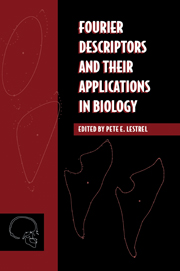Book contents
- Frontmatter
- Contents
- List of contributors
- Preface
- Acknowledgments
- Part one Theoretical considerations
- Part two Applications of Fourier descriptors
- 6 Closed-form Fourier analysis: A procedure for extraction of ecological information about foraminiferal test morphology
- 7 Fourier descriptors and shape differences: Studies on the upper vertebral column of the mouse
- 8 Application of the Fourier method on genetic studies of dentofacial morphology
- 9 Fourier analysis of size and shape changes in the Japanese skull
- 10 Craniofacial variability in the hominoidea
- 11 Heuristic adequacy of Fourier descriptors: Methodologic aspects and applications in Morphological
- 12 Analyzing human gait with Fourier descriptors
- 13 Elliptic Fourier descriptors of cell and nuclear shapes
- 14 Cranial base changes in shunt-treated hydrocephalics: Fourier descriptors
- 15 A numerical and visual approach for measuring the effects of functional appliance therapy: Fourier descriptors
- 16 Size and shape of the rabbit orbit: 3-D Fourier descriptors
- 17 From optical to computational Fourier transforms: The natural history of an investigation of the cancellous structure of bone
- 18 Epilogue: Fourier methods and shape analysis
- Appendix
- Glossary
- Index
14 - Cranial base changes in shunt-treated hydrocephalics: Fourier descriptors
Published online by Cambridge University Press: 14 September 2009
- Frontmatter
- Contents
- List of contributors
- Preface
- Acknowledgments
- Part one Theoretical considerations
- Part two Applications of Fourier descriptors
- 6 Closed-form Fourier analysis: A procedure for extraction of ecological information about foraminiferal test morphology
- 7 Fourier descriptors and shape differences: Studies on the upper vertebral column of the mouse
- 8 Application of the Fourier method on genetic studies of dentofacial morphology
- 9 Fourier analysis of size and shape changes in the Japanese skull
- 10 Craniofacial variability in the hominoidea
- 11 Heuristic adequacy of Fourier descriptors: Methodologic aspects and applications in Morphological
- 12 Analyzing human gait with Fourier descriptors
- 13 Elliptic Fourier descriptors of cell and nuclear shapes
- 14 Cranial base changes in shunt-treated hydrocephalics: Fourier descriptors
- 15 A numerical and visual approach for measuring the effects of functional appliance therapy: Fourier descriptors
- 16 Size and shape of the rabbit orbit: 3-D Fourier descriptors
- 17 From optical to computational Fourier transforms: The natural history of an investigation of the cancellous structure of bone
- 18 Epilogue: Fourier methods and shape analysis
- Appendix
- Glossary
- Index
Summary
Introduction
It is now well established that the growth of the brain is a major factor in shaping the craniofacial complex, particularly the cranial vault (Moss and Young, 1960). Numerous studies have also suggested that the cranial base (CB) plays a role in determining the shape of the craniofacial complex (Bjork, 1955; Enlow, 1976; Kerr and Adams, 1988). Intracranial pressure may also be implicated in the postnatal development of the CB. For example, the prolonged increased intracranial pressure in uncontrolled hydrocephalus (HC) results in well-defined cranial vault as well as CB changes (Kantomaa et al., 1987), which have been confirmed by experimentally induced HC in rats (Hoyte, 1991).
The most important factor in controlling HC is to maintain an adequate subdural pressure (Hakim and Hakim, 1984). A valve-regulated shunt device which insures unidirectional cerebrospinal fluid (CSF) circulation, has markedly improved prognosis for HC children (Fernell et al., 1988). However, this treatment modality is still prone to various complications such as shunt obstructions, mechanical failures, infections, and overdrainage of CSF (Serlo, 1985).
Earlier studies have shown definitive abnormalities in CB morphology. For example, a smaller sella turcica and the planum sphenoidale thickened and displaced superiorly (Kaufman et al., 1970). A cephalometric evaluation of five adults with untreated HC revealed that the CB was flat and anteriorly elongated (Kantomaa et al., 1987).
- Type
- Chapter
- Information
- Fourier Descriptors and their Applications in Biology , pp. 322 - 339Publisher: Cambridge University PressPrint publication year: 1997



